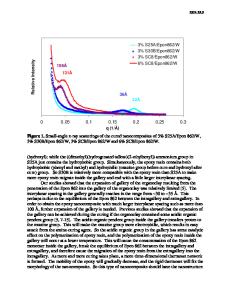Preparation of a transparent and flexible self-standing film of layered titania/isostearate nanocomposite
- PDF / 681,737 Bytes
- 8 Pages / 612 x 792 pts (letter) Page_size
- 90 Downloads / 296 Views
Satoru Masaki, Tomohito Imai, Wataru Sugimoto, Yoshio Takasu, and Yasushi Murakami Department of Fine Materials Engineering, Faculty of Textile Science and Technology, Shinshu University, Ueda 386-8567, Japan (Received 19 August 2004; accepted 15 February 2005)
A titania-based self-standing film with high transparency and flexibility was successfully prepared via a sol-gel process, in which a titanium tetraisopropoxide/ isostearate complex (precursor), n-hexylammonium isostearate (catalyst), and o-xylene (solvent) were used. The sol obtained by the sol-gel reaction was floated on a water surface to form an unsupported film. This film was composed of a titania/isostearate nanocomposite with ordered layer structure. The basal spacings of the nanocomposites depended on the chain length of the carboxylate modifier.
I. INTRODUCTION
Recently, the preparation of inorganic/organic nanocomposites by the sol-gel process has been intensively investigated.1–3 Of the various inorganic/organic nanocomposites, layered nanocomposites consisting of stacked oxide sheets belong to one of the most important material systems because these materials have potential applicability as adsorbents, catalysts, and hosts for various guest molecules. So far, a large number of papers have been published on the synthesis of silica-based layered nanocomposites obtained by the sol-gel reaction of silicon alkoxide in the presence of surfactants forming micelle templates.4–7 Processing these materials into thin films is another important subject, especially from a technological point of view. A large number of papers have reported the synthesis of supported films of nanocomposites;5–8 however, the films required for practical application are unsupported ones. Self-standing films would find wide application, such as catalyst supports and separation membranes, for which supported films are not suitable. The preparation of transparent self-standing films of silicabased nanostructured materials was already reported by Ogawa and his co-workers.9,10 They prepared transparent films of layered silica/surfactant nanocomposites from tetramethoxysilane and obtained self-standing films by peeling the dried films off a polyethylene substrate.9
a)
Address all correspondence to this author. e-mail: [email protected] DOI: 10.1557/JMR.2005.0165 1308
http://journals.cambridge.org
J. Mater. Res., Vol. 20, No. 5, May 2005 Downloaded: 16 Mar 2015
They also prepared thin films of the silica/surfactant mesostructured materials by removing the films from PMMA-coated glass substrates by dissolving the intervening [poly(methyl methylacrylate)] (PMMA).10 In these works on the synthesis of silica-based nanocomposite films, silica/alkyltrimethylammonium complexes were assembled by the hydrophobic interaction between the long alkyl chains in aqueous solution, and an ordered structure was constructed on the substrate by condensation due to the evaporation of the solvent.7,8 The preparation and characterization of titania (TiO2) is one of the subjects of current rese
Data Loading...











